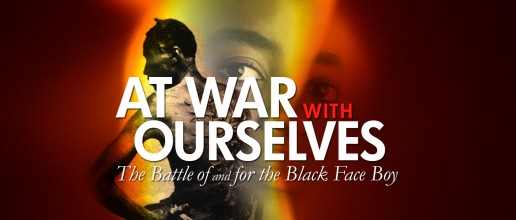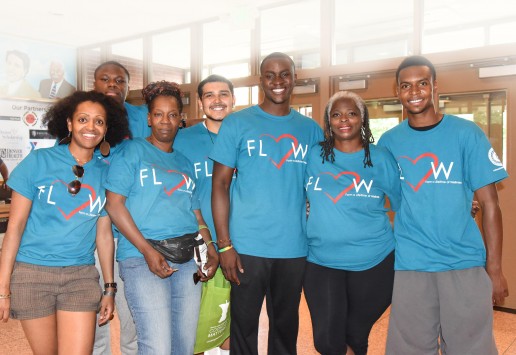Animation ‘At War With Ourselves’ screened at 2015 ‘NextNow Fest’ and PGAAMCC Gallery
The animated short ‘At War With Ourselves: The Battle of and for the Black Face Boy’ written and voiced by renown poet Nikky Finney screened at 2015 ‘NextNow Fest’ at the University of Maryland’s Clarice Smith Center and as a featured in a recent exhibition of the same title at the Prince George’s African American Museum and Cultural Center in North Brentwood, MD (PGAAMCC).
This early version of the video was co-produced with students from Cultural Keepers, PGAAMCC’s after school arts education program at the Center for Visual and Performing Arts at Suitland High School.
'FLOW' Cardiovascular Health Campaign Launches in Denver
CBHC has done it again!
On Saturday, August 30th Colorado Black Health Collaborative launched their citywide cardiovascular health campaign at the 2015 Black Family Reunion / Health Expo event. The 'FLOW" campaign, (FORM A LIFETIME OF OPTIMAL HEALTH) will link members of the community that are most at-risk for CV disease to care and also raise aware through a series of public health messages by Ascender. The FLOW campaign creative will feature the stories about real residents overcoming CV diseases like high blood pressure.
Stay tuned as we roll-out more creative from this exciting project, funded in part by the Centers for Disease Control.
When you are alone
You will remember the people more than the place.
When you are alone for days or weeks at a time, you eventually become drawn to people. Talking to randos is the norm. I’ll never forget the conversation with the aquarium fisherman, forest ranger, and women at the Thai market. It’s refreshing to compare notes on life with people from vastly different backgrounds.
When you meet fellow travelers, you’ll find they are also filled with a similar sense of adventure and curiosity about the world. Five days of friendship on the road is like five months of friendship at home. It’s the experiences that bond you together, not the place. A rule I followed that worked well: be the first to initiate conversation. I met some incredible people by simply being the first to talk.
Make a radical change in your lifestyle and begin to boldly do things which you may previously never have thought of doing, or been too hesitant to attempt. But once you become accustomed to such a life you will see its full meaning and its incredible beauty.
Travel can be affordable.
Long term travel is different than a luxury vacation. The point is to see the world, not stay in a 5-star hotel. During the trip, I stayed on a strict budget. The goal was to spend no more than $33 per day on accommodations. After a year, I was able to spend only $26.15 per day by booking through HostelWorld and Airbnb. When I wanted to meet people, I’d stay in a shared room at a hostel. When I wanted to be alone, I’d book a private room with Airbnb.
Take the cost of your rent or mortgage + food per month and divide it by 30. This is how much it costs per day to live at home. You will find that it’s possible to travel the world for roughly the same amount. Or, if you live in an expensive city like San Francisco, far less.
English is a universal language.
I was surprised how many people spoke English (apparently 1.8 billion people worldwide). Places where English was less prevalent, I made an effort to learn a handful of words and phrases in the local language. Even though it’s passable, I do desire to learn another language fluently. You can only take the conversation so far when all you can say is: “¿Esto contiene gluten?”
It’s possible to communicate a lot without saying a word. For instance, I left my phone at a restaurant in Chile. I pointed at the table where I was sitting, put my hand to my ear like a phone, then shrugged — 2 minutes later, my phone had been retrieved.
Trust your intuition.
I learned to trust that tiny voice in my head a bit more. When you are alone in a foreign country and your phone is dead, you are forced to trust your intuition. Is this neighborhood safe to walk around? Is this person someone I should interact with? Am I heading the right direction? Intuition is like a muscle. The more you use it, the stronger it becomes. It’s feels like a sixth sense when you’re able to read between the lines of a situation.
The world is endless. The world’s a tiny neighborhood. My fav people are the ones who can hold two impossible ideas in their heads.
Me Myself and I
Many years ago, I worked for my parents who own a video production company. Because it is a family business, you inevitably end up wearing many hats and being the czar of many different jobs. I mainly managed projects and worked as a video editor. On production, there were times that I was called on to work as an audio tech and was made to wear headphones on long production days. In those days, having a really good set of headphones that picked up every nuance of sound was essential to making sure the client got what they needed.
First impressions.
Naturally, my first impression of these headphones is based off of the look of them. They have a classic over-the-ear style that is highlighted by a blue LED light that indicates the power for the noise canceling. The padding on the ear pieces seems adequate for extended usage periods.
They are wired headphones, but the 3.5mm stereo mini-plug cable is detachable. Something else I noticed right of the bat was the very nice carrying case that comes with them. It has a hard plastic exterior with a soft cloth interior that helps to protect the surface of the headphones from scratches. I never truly appreciated cases for headphones until I started carrying them from place-to-place. Now I can’t imagine not having a case.
A perfect fit.
Once I gave the headphones a thorough once-over exam, I tried them on. As I mentioned, they have a classic over-the-ear style and just looking at them, the padding on the ear pieces seem adequate and the peak of the headband seemed to be a bit lacking, but you don’t really know comfort unless you try on the product. So, I slipped the headphones on and found them to be exquisitely comfortable.
It’s safe to say that because of my unique professional experiences, I’ve tested out a lot of headphones.
Quality.
Now that I had the headphones on my head, I was finally ready to plug and play some music. I plugged the provided cable into the jack on the headphones and then the one on my iPhone 6. Then I called up Pandora. I tend to have a very eclectic music purview and have many stations set up for different moods. From John Williams to Fallout Boy, the sound quality of these headphones was remarkable. There is an amazing depth of sound and incredible highs and lows that make listening to music a truly breathtaking experience.
In order to test how voices sounded, and the overall art of sound mixing, I pulled up Netflix on my iPad Air 2 and watched a few minutes of a movie to hear all the nuances of the film. None of them were lost. In fact, I ended up hearing sounds that I hadn’t heard before. Echoes…birds chirping…wind blowing through trees…breathing of the characters…it was very impressive what the headphones ended up bringing out for me.
I would highly recommend these to any sound mixing specialist.
My tech travel setup
MacBook Pro
Robert Capa, a famous photojournalist once said, “If your pictures aren’t good enough, you’re not close enough.” It’s not just about zooming in with your lens, either. It’s about getting physically closer to people and getting to know them better. It’s also about spending a little time with a stranger before taking their photo. That helps build the trust and comfort that’ll come through in your pictures. Walk up to your subject with a simple wave and a smile to help communicate that you mean no harm.
Ask permission to take a photo if they speak the same language as you. If you don’t share a language, try learning some basic phrases ahead of time, gesture at your camera and ask through expression. Of course if someone doesn’t want their picture taken, it’s imperative to respect their wishes and move on — people are always more important than photographs. National Geographic writes that “making great pictures is primarily a mental process.” What makes you want to photograph the person or place? How might you describe it to a friend, and what adjectives would you use? Are there details you can focus on that tell a story?
iPad/iPhone
Maybe it’s a dry, arid desert, captured by focusing on the patterns of cracked earth. Or a prairie that’s photographed with the horizon at the bottom of the frame, to help create a sense of the open sky and tranquility. Or maybe it’s the story of a deft artisan, fingernails covered in wet clay as she molds a pot. When you’re on the road it can be tough to eat right and make sure you get all the right nutrients. I started taking daily supplements of Multi-Vitamin, Fish Oil capsules and Vitamin D and it helps a lot. Especially the Vitamin D since I don’t get to see the sun a lot during the winter in Sweden.
Sennheiser HD-25 Headphones
It’s difficult to recreate the grandeur of a vast landscape in the confines of a picture frame. But one way to add a sense of depth to your photos is to compose them with objects in the foreground that support the scene. It can be as simple as a winding road through a national park, or some rocks to show off the local geology.
If you’re taking photos of people during normal daylight hours, a quick way to get more flattering light is to move the person out of direct sunlight. The light is much “softer” and doesn’t cast stark, unflattering shadows across their facial features. Even better, have someone stand next to an open door or window as the single source of light.
You have to learn the rules of the game. And then you have to play better than anyone else.
Albert Einstein
I was recently quoted as saying, “I don’t give a shit” if Instagram has more users than Twitter. If you read the article you’ll note there’s a big “if” before my not giving of said shit.
Of course, I am trivializing what Instagram is to many people. It’s a beautifully executed app that enables the creation and enjoyment of art, as well as human connection, which is often a good thing. But my rant had very little to do with it (or with Twitter). My rant was the result of increasing frustration with the one-dimensionality that those who report on, invest in, and build consumer Internet services talk about success.
Numbers are important. Number of users is important. So are lots of other things. Different services create value in different ways. Trust your gut as much (or more) than the numbers. Figure out what matters and build something good.
The new brand identity
I stumbled upon the concept of margin while reading a post by Michael Hyatt, which led me to design my ideal week. Richard Swenson, M.D. (who wrote the book: Margin: Restoring Emotional, Physical, Financial, and Time Reserves to Overloaded Lives) describes margin like this:
Margin is the space between our load and our limits. It is the amount allowed beyond that which is needed. It is something held in reserve for contingencies or unanticipated situations. Margin is the gap between rest and exhaustion, the space between breathing freely and suffocating.
Last year I wrote about why booking too far in advance can be dangerous for your business, and this concept of margin so eloquently captures what I had recognized had been my problem: I was so booked up with clients that I wasn’t leaving any margin for error, growth, planning, or reflection. I wasn’t really growing my business in a sustainable way; I was just booking one client after the next. At the time this seemed like a good thing: doesn’t growing my business mean getting more clients?
A long redesign.
What if instead of booking up to 100% capacity (which more often than not ends up being closer to 120%), we only booked up to an 80% capacity?
What if we left more room for growth (personal or professional) and stopped being one with “busy-ness”?
I spent nearly a year turning down every new project (and even getting rid of old ones) so that I could reduce my workload, build in more margin, and create what is now Digital Strategy School. It takes time to build margin into your schedule.Write a book. Create a program. Update your contracts and proposals (which has been on your to-do list for how long..?) Spend more time with your family. Go above and beyond for a client. Learn something new. Actually follow through on the things that have been nagging at you for a long time.
When you design your ideal week, you start to see that the time you think you have is often not in alignment with how much time you actually have.
After designing my ideal week, I had a much clearer idea of how to create a framework for my week that would empower me to feel more focused by theming days of the week, and even parts of the day. SO simple, I know. Some of you have been doing this for ages and you’re already a pro, and some of you who saw my schedule said “woah, that’s so rigid, I need more flexibility!”
Structure enables flexibility.
If you’re not sure how much time you are actually spending on various tasks, use a tool like Rescue Time (their free version is excellent!) which runs in the background and tracks where your time is being spent. It can even send you weekly reports so you know exactly how much time you wasted on Facebook, or spent in your email inbox! You can assign different websites or programs/applications on a scale of very distracting to very productive, so you can see at a glance things like: which days of the week you’re most productive, which times of the day you’re most productive, and the sites on which you’re spending the most distracting time. Turns out I’m consistently “in the zone” around 3pm in the afternoon; so instead of trying to tackle highly creative work first thing in the morning (when my brain is barely functioning), I handle it in the afternoon, when I know I’m at my peak!
Creating more margin has been game-changing for my business.
What would be possible for yours?
Some amazing buildings
Minimalism and geometric.
When you are alone for days or weeks at a time, you eventually become drawn to people. Talking to randos is the norm. I’ll never forget the conversation with the aquarium fisherman, forest ranger, and women at the Thai market. It’s refreshing to compare notes on life with people from vastly different backgrounds.
When you meet fellow travelers, you’ll find they are also filled with a similar sense of adventure and curiosity about the world. Five days of friendship on the road is like five months of friendship at home. It’s the experiences that bond you together, not the place. A rule I followed that worked well: be the first to initiate conversation. I met some incredible people by simply being the first to talk.
Long term travel is different than a luxury vacation. The point is to see the world, not stay in a 5-star hotel. During the trip, I stayed on a strict budget. The goal was to spend no more than $33 per day on accommodations. After a year, I was able to spend only $26.15 per day by booking through HostelWorld and Airbnb. When I wanted to meet people, I’d stay in a shared room at a hostel. When I wanted to be alone, I’d book a private room with Airbnb.
Take the cost of your rent or mortgage + food per month and divide it by 30. This is how much it costs per day to live at home. You will find that it’s possible to travel the world for roughly the same amount. Or, if you live in an expensive city like San Francisco, far less.
An universal language.
I was surprised how many people spoke English (apparently 1.8 billion people worldwide). Places where English was less prevalent, I made an effort to learn a handful of words and phrases in the local language. Even though it’s passable, I do desire to learn another language fluently. You can only take the conversation so far when all you can say is: “¿Esto contiene gluten?”
It’s possible to communicate a lot without saying a word. For instance, I left my phone at a restaurant in Chile. I pointed at the table where I was sitting, put my hand to my ear like a phone, then shrugged — 2 minutes later, my phone had been retrieved.
Working from your home?
01. Wake up at the same time every day.
Naturally, my first impression of these headphones is based off of the look of them. They have a classic over-the-ear style that is highlighted by a blue LED light that indicates the power for the noise canceling. The padding on the ear pieces seems adequate for extended usage periods.
They are wired headphones, but the 3.5mm stereo mini-plug cable is detachable. Something else I noticed right of the bat was the very nice carrying case that comes with them. It has a hard plastic exterior with a soft cloth interior that helps to protect the surface of the headphones from scratches. I never truly appreciated cases for headphones until I started carrying them from place-to-place. Now I can’t imagine not having a case.
It’s funny — the thing I feared would take away my “freedom” is the one thing that has allowed me to have it.
Joelle Steiniger
02. Have a routine when you wake up.
Once I gave the headphones a thorough once-over exam, I tried them on. As I mentioned, they have a classic over-the-ear style and just looking at them, the padding on the ear pieces seem adequate and the peak of the headband seemed to be a bit lacking, but you don’t really know comfort unless you try on the product. So, I slipped the headphones on and found them to be exquisitely comfortable. In order to test how voices sounded, and the overall art of sound mixing, I pulled up Netflix on my iPad Air 2 and watched a few minutes of a movie to hear all the nuances of the film. None of them were lost. In fact, I ended up hearing sounds that I hadn’t heard before. Echoes…birds chirping…wind blowing through trees…breathing of the characters…it was very impressive what the headphones ended up bringing out for me.

I’d start my day by checking email, Twitter, Facebook. Reading the “news”. I’d look at my to-do list and start working on something.
03. Plan your workout time — stick to it.
Now that I had the headphones on my head, I was finally ready to plug and play some music. I plugged the provided cable into the jack on the headphones and then the one on my iPhone 6. Then I called up Pandora. I tend to have a very eclectic music purview and have many stations set up for different moods. From John Williams to Fallout Boy, the sound quality of these headphones was remarkable. There is an amazing depth of sound and incredible highs and lows that make listening to music a truly breathtaking experience.
In order to test how voices sounded, and the overall art of sound mixing, I pulled up Netflix on my iPad Air 2 and watched a few minutes of a movie to hear all the nuances of the film. None of them were lost. In fact, I ended up hearing sounds that I hadn’t heard before. Echoes…birds chirping…wind blowing through trees…breathing of the characters…it was very impressive what the headphones ended up bringing out for me.
Distractions aside, there was no real rhyme or reason to my workflow. The not-so-fun (but necessary) stuff kept getting neglected.

04. Call it a night.
Now that I had the headphones on my head, I was finally ready to plug and play some music. I plugged the provided cable into the jack on the headphones and then the one on my iPhone 6. Then I called up Pandora. I tend to have a very eclectic music purview and have many stations set up for different moods. From John Williams to Fallout Boy, the sound quality of these headphones was remarkable. There is an amazing depth of sound and incredible highs and lows that make listening to music a truly breathtaking experience.
In order to test how voices sounded, and the overall art of sound mixing, I pulled up Netflix on my iPad Air 2 and watched a few minutes of a movie to hear all the nuances of the film. None of them were lost. In fact, I ended up hearing sounds that I hadn’t heard before. Echoes…birds chirping…wind blowing through trees…breathing of the characters…it was very impressive what the headphones ended up bringing out for me.

Here it is! Best Websites Around The World 2014 is now on sale! Find out more: http://t.co/Pzesyl5ENP pic.twitter.com/Oo0OlDwexH
awwwards. (@awwwards) March 6, 2015
I was recently quoted as saying, “I don’t give a shit” if Instagram has more users than Twitter. If you read the article you’ll note there’s a big “if” before my not giving of said shit.
Of course, I am trivializing what Instagram is to many people. It’s a beautifully executed app that enables the creation and enjoyment of art, as well as human connection, which is often a good thing. But my rant had very little to do with it (or with Twitter). My rant was the result of increasing frustration with the one-dimensionality that those who report on, invest in, and build consumer Internet services talk about success.
Numbers are important. Number of users is important. So are lots of other things. Different services create value in different ways. Trust your gut as much (or more) than the numbers. Figure out what matters and build something good.






